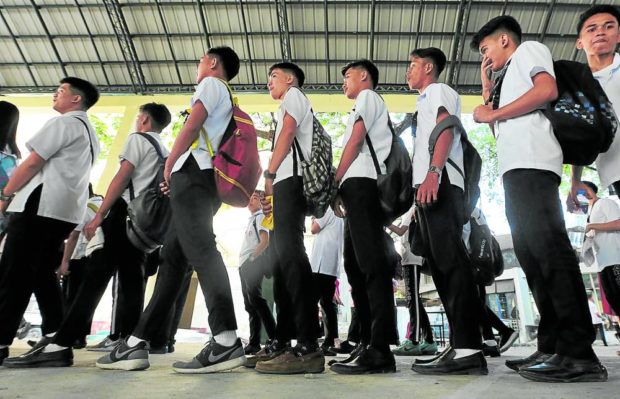PISA shows PH students ‘5 to 6 years’ behind

READY FOR A JOB? Junior high school students rehearse for their “moving up” program at Manila’s Araullo High School in this March 21, 2018, file photo. A study published in 2020 showed that over 20 percent of senior high school graduates had entered the country’s workforce while more than 70 percent opted to continue their studies. (File photo by GRIG C. MONTEGRANDE / Philippine Daily Inquirer)
MANILA, Philippines — Based on the results of the 2022 Programme for International Student Assessment (Pisa), the Filipino students who took part were five to six years behind in mathematics, science, and reading compared to their 15-year-old counterparts from most of the participating countries.
The Department of Education (DepEd), however, remained optimistic during a forum it organized on Wednesday, saying the results, which showed the Philippines ranking sixth to the last in reading and mathematics and third to the last in science among 81 countries, indicated that the country’s education system was “resilient.”
The results of the latest Pisa showed that the Philippines’ performance in the three subjects remained low and “were about the same” as in 2018, when it first took part in the assessment.
Pisa is conducted by the Organization for Economic Cooperation and Development (OECD) to evaluate the academic performance of 15-year-old students in reading, mathematics and science every three years.
READ: 1 in 3 Filipino students bullied in school – Pisa study
No statistical change
In the 2018 assessment, the country scored the lowest in reading and second lowest in math and science among 79 participants.
Article continues after this advertisementFor the 2022 Pisa, although the average scores of Filipino students in mathematics and reading went up by a few points compared to the previous study, the changes did not show any statistically significant improvement, the report noted.
Article continues after this advertisementFrom an average score of 353 in mathematics in 2018, this went up to 355. In reading, it went from 340 in 2018 to 347 while in science, it declined by one point, from 356 compared to 357 in 2018.
These scores, however, were still way lower than the average in OECD countries, which showed the performance gap between the Philippines and the 80 other participating nations.
DepEd education program specialist and Pisa focal person Alexander Sucalit Jr. cited the report’s estimate that every 20 points represented the average annual learning pace of 15-year-olds in countries that took part in Pisa.
Following the formula, in mathematics, the Philippines’ average score was 129 points lower than the OECD average. Dividing the number by 20 points, the students were behind by around 6.45 years in math education compared to other countries.
Different paces
“But we have to be cautious in using this in making our conclusions and interpretations because different countries have different paces of learning,” Sucalit told reporters.
Following the computation and considering the caveat that the point of comparison were OECD countries with socioeconomically advantaged students, he said that Filipino students were “around five to six years” behind in schooling.
In her presentation of the Pisa results during the forum, Education Undersecretary Gina Gonong said that between 2018 and 2022, the performance of the country’s 15-year-old students in the three subject domains “remained stable despite the COVID-19 pandemic.”
Although Vice President and Education Secretary Sara Duterte was not at the forum held at the DepEd central office in Pasig City, various education stakeholders were present, including lawmakers like Sen. Sherwin Gatchalian, Pasig Rep. Roman Romulo, representatives from the academe, private sector and other partner organizations.
‘Uncomfortable truth’
In a video message, Duterte said the latest Pisa results “may bear [an] uncomfortable truth” as a significant majority of the students fell “below the proficiency level required for full participation in society and contributing to nation-building.”
The DepEd, however, remained optimistic, with Gonong pointing out that the performance of Filipino students was “positive in the sense that many other countries’ performance fell.”
“So we maintained our performance before the pandemic and that shows that our performance is stable and our education system is resilient,” she said.
Romulo shared the same sentiment, saying that interpreting the Pisa results was “always a matter of perspective.”
“During the pandemic when classes were practically online, many students did not have technology, many did not even know how to use technology, we held the line … We should be happy, we held the line compared to other countries,” he said.
Romulo stressed the need to “institute the much needed reforms, moving forward” by focusing on “reading, reading, reading, comprehension and mathematical skills” that were age-appropriate.
Pandemic factor
Education Undersecretary and chief of staff Michael Poa said the pandemic contributed to the “stagnant” performance of the country.
The scores, he added, did not improve because the supposed reforms and interventions since the 2018 Pisa were not immediately implemented.
“But more than that, reforms really take time,” Poa said, adding that the learning recovery programs being implemented recently would not immediately reflect next year.
Gonong said they were aiming to make Filipino students top performers in the international assessment but they were not sure when it would happen “because 2025 is such a short time from now,” referring to the next Pisa assessment.
In particular, the DepEd wanted to keep up with other Southeast Asian countries like Vietnam, Thailand and Malaysia in the coming years, “maybe 2029 onward.”
In a statement, the private sector-led advocacy group Philippine Business for Education said that the country’s dismal ranking in the 2022 Pisa for the second time was a “clear indication that our education system is in its worst state and much work needs to be done.”
“The weaknesses in our basic education system will eventually translate into the weakness of our workforce, affecting the productivity and key source of our economic growth and competitiveness,” it added. “A crisis of this magnitude requires swift action and great effort from all sectors.” —WITH A REPORT FROM JULIE M. AURELIO